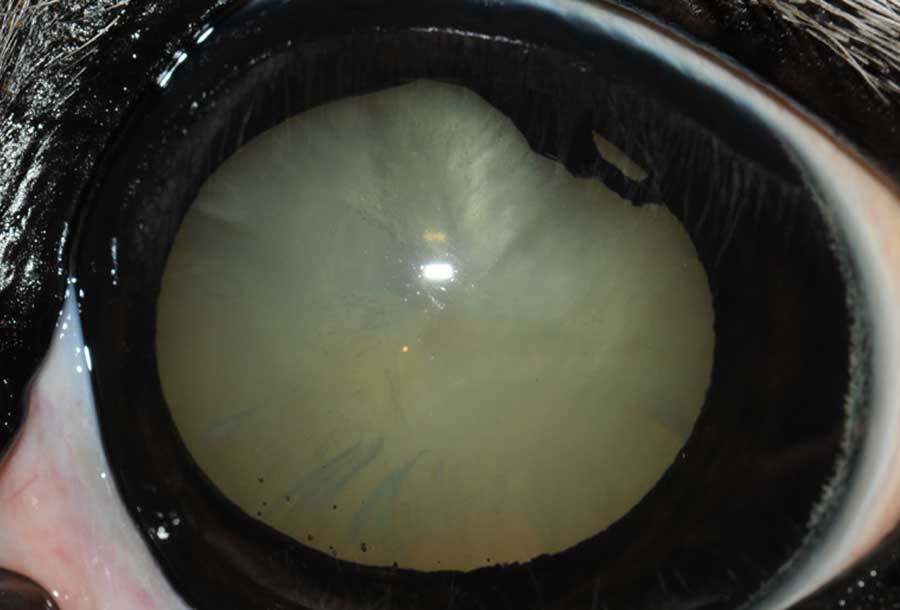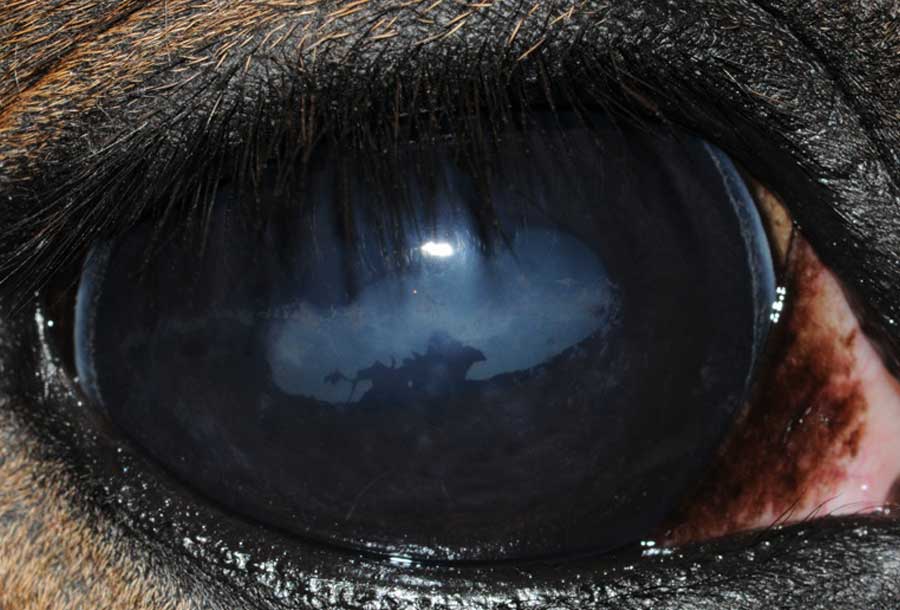Equine Ophthalmology: Recurrent Uveitis
Equine recurrent uveitis (ERU), or “moon blindness,” is the most common cause of blindness in horses.
The term “uveitis” comes from the word “uvea”, which refers to the inner tissues of the eye, including the iris (colored part of the eye). The “-itis” part of “uveitis” means inflammation, so uveitis is a name for a group of diseases that cause inflammation inside of the eye.
ERU is caused by an overreaction of the horse’s immune system, which causes inflammation in the eye. Typically this occurs after an initial ocular injury or infection. Exposure to a bacteria, virus, parasite or other irritant will trigger the immune system to turn on and the inflammation the body produces starts a cycle of damage. Leptospirosis, a bacterial infection caused by coming in contact with Leptospira contaminated water, is a known trigger for ERU.
Symptoms
Uveitas can be divided into two varieties based on symptoms. The first type being a more gradual progression, which is difficult for owners to spot until their horse begins to show symptoms of vision loss. This type involves low grade, consistent inflammation that causes damage over time and leads to vision loss- but is not painful for the horse. Owners become concerned when their horse begins running into things, spooking more often, or having trouble navigating the ground.
This gradual progression type of ERU is more common in Appaloosa horses.
The second type of uveitis is more obvious sooner to owners. The horse’s eye(s) produce tears, a mucous discharge, and the normally white/pink tissue around the eye turns bright red. The horse may also squint or rub their eyes, and the eyelid could become puffy or swollen. These symptoms may vary, and appear seasonally, at times of stress, or after vaccinations and deworming. The periods of discomfort occur when inflammation peaks, and are followed by periods of comfort when the inflammation subsides or is gone.
Diagnosis
Diagnosis of ERU is done by a complete ophthalmic examination, we recommend a full examination by a board-certified veterinary ophthalmologist. The exam includes utilizing specialized equipment to look at a microscopic view of all parts of the eye, a fluorescein dye test to evaluate the health of the cornea, tonometry to check for glaucoma, and if possible pupil dilation and a retinal exam. Sometimes an ocular ultrasound is necessary to view the back chamber of eye if the pupil will not dilate well, or a cataract is present. The ultrasound can offer more information about any damage present in the back of the eye, such as a retinal detachment, allowing a more accurate prognosis for vision.
Treatment
Treatment for uveitis in general depends upon the underlying cause as well as the severity of the symptoms. In most cases, the eye is treated with topical anti-inflammatories and a pupil-dilating agent to decrease the pain and inflammation. Oral anti-inflammatories such as Banamine® (Flunixin meglumine) are also instituted, and in select cases bodily injections of steroids may be necessary. While these treatments are helpful in subsiding the inflammation and pain – they’re not ideal for long-term use. If infectious disease is suspected to be the cause, laboratory tests should be performed followed by medical treatment if recommended. If a horse responds favorably to medical therapy, Cyclosporine Implants may be an option for long-term management. This is the surgical implantation of a small Cyclosporine medicated disc that’s placed deep within the pink tissue surrounding the eye (sclera), it slowly releases medication over a period of several years. This medication modifies the reaction to the immune system and reduces inflammation.
Cyclosporine
Cyclosporine is an immunosuppressant drug that is commonly used for treatment to prevent organ transplant rejection and for treatment of dry eyes in dogs. Cyclosporine is the ideal drug to prevent the recurrence of immune-mediated ocular inflammation. It suppresses the activity of the T-lymphocyte, which is the most common infiltrating cell in ERU eyes.
However, cyclosporine eyedrops or ointment do not penetrate past the cornea. Therefore it cannot get into the eye to treat the uveitis. Oral cyclosporine would likely be too toxic and expensive to give a horse to prevent ERU.
Sustained-release cyclosporine
Studies performed at NC State have shown that reservoir devices placed into the eye can allow long-term (more than 4 years) release of low levels of cyclosporine. Studies have shown that the implants are safe and effective in decreasing inflammation in the equine eye. Clinical studies in horses with ERU have shown excellent control of the disease. However, this is an experimental device and not approved for use in horses by the FDA.
Is my horse a candidate?
The best candidates for the implant are those with the following characteristics:
- ERU is controllable with traditional medication, but the horse has frequent recurrences
- The horse has good vision between episodes
- The horse has minimal scarring in the eye and no cataract formation
- There is no retinal degeneration and has good retinal function
- The horse does not have other systemic illnesses (such as a high titer to leptospirosis)
Your veterinarian’s examination will help determine if your horse is a good candidate.
Who can do the surgery?
There are veterinary ophthalmologists in nearly all areas of the US who are or will be trained to perform the implant surgery. Please call us to determine the closest ophthalmologist in your area.
What are the success rates?
This is an experimental procedure, however, long-term results have shown that greater than 80% of horses have ERU controlled. Some horses have lost vision after implantation.


